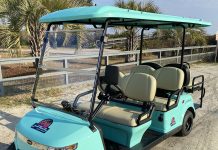PLEASE NOTE: Golf Cart Laws may vary from City to City, so please be sure to check with your local municipality in regards to the laws in your area. We are in the process of gathering laws by municipality for you, however, this is a huge undertaking and does take time. Thank you.
This is an in-depth guide to Ohio Golf Cart & Low-Speed Vehicle Laws. We’ve created this guide to help you, the consumer, in determining Ohio’s laws.
Is this state Medium Speed Vehicle friendly? No State Law is Currently in Place.
Is License and Registration a Requirement? For both LSVs and Golf Carts, Yes. Liability insurance is also required. Golf Carts are treated just like any other motor vehicle.
General Federal Law for Golf Carts:
Under current NHTSA interpretations and regulations, so long as golf cars and other similar vehicles are incapable of exceeding 20 miles per hour, they are subject to only state and local requirements regarding safety equipment. However, if these vehicles are originally manufactured so that they can go faster than 20 miles per hour, they are treated as motor vehicles under Federal law.
The standard requires low-speed vehicles to be equipped with headlamps, stop lamps, turn signal lamps, taillamps, reflex reflectors, parking brakes, rearview mirrors, windshields, seat belts, and vehicle identification numbers.
For more information on the federal laws pertaining to golf carts, please click here.
Ohio Golf Cart & Low Speed Vehicle Laws
Guidelines for Golf Carts and PTVs (Personal Transportation Vehicles)
A permitted golf cart may ONLY operate on a secondary highway or street for which the posted speed limit is 35 MPH or less.
The driver of the golf cart must be at least 16 years of age and hold a valid driver’s license. You must bring the following with you to register the golf cart:
- A completed inspection from local law enforcement
- Application for Certificate of Title to a Motor Vehicle form (BMV 3774)
- Proof of ownership e.g. Manufacture Certificate of Origin (MCO), assigned title from this state or another, bill of sale from a retail business or individual, sworn statement of ownership, or other evidence required by law of another state from which the vehicle was brought into this state
- Sales tax on purchase price (sales tax rates by county are available HERE)
- Payment for title fees, including a lien holder notation (if applicable)
Required Equipment for Operating a Golf Cart on Ohio Roads:
- Adequate brakes and braking system;
- Equipped with properly working brake lights, head lights, tail lights, and warning devices, also known as turn signals;
- A properly working steering mechanism
- A windshield to prohibit injury from any debris from the roadway
- A rear view mirror to reflect the operator a view of the public street or highway to the rear
- Appropriate tires that are free of major bumps, bulges, breaks, or any condition that would be cause for unsafe conditions
Guidelines for LSV (Low Speed Vehicle)
- Reaches speeds of 20 MPH to 25 MPH.
- Has a vehicle identification number (VIN)
- Headlamps
- Front and rear turn signals
- Taillamps
- Stop lamps
- Reflex reflectors, red – one on each side and one on the rear
- Exterior mirror on the driver side and an interior mirror or exterior mirror on passenger side
- Parking brake
- Windshield
- Seatbelt for each designated seat
- Not be operated on any roadway with a speed limit above 35 mph.
Any person operating a low-speed vehicle (LSV) must have in their possession a valid driver license. An LSV must also be registered and insured with Personal Injury Protection and Property Damage Liability.
Click here for more information on Low Speed Vehicle Laws in Ohio
Disclaimer
Although each of these state guides gives a thorough approach to the golf cart laws in your state, it is recommended that you perform the research on your own and reach out to your local municipality.
Recent News & Helpful Articles












